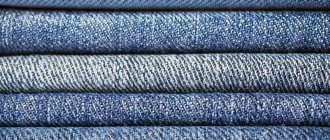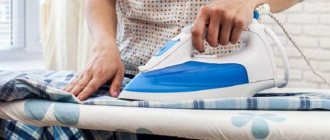Author: Fon_Enot
16 September 2021 19:28
Community: Crafts for beginners and masters
Tags: handmade lifehack girls lifehacks why handmade needlework handmade sewing
21221
4
Handmade is held in high esteem. More and more girls are trying to learn how to sew and are buying sewing machines. But at first, even an expensive and automated machine can stitch unevenly. This is frustrating and discourages the desire to become a craftswoman. Why can the machine make an uneven stitch?
0
The reason for skipping stitches with a sewing machine must be sought in one of three components:
- needle
- threads
- fabric Seamstresses who have been using the machine for a long time know the main reasons and can easily eliminate the defect. For beginning craftswomen, skipping a stitch can lead to a state where they want to give up everything and never sit down at the machine again. Don’t rush to despair - everything can be fixed.
Identifying the problem thread
Before starting work, regardless of which machine it will be used, it is necessary to thread the working threads. The operating principle for all devices will be identical. Preparation must be carried out with the device turned on, with the presser foot in the upper position.
The top thread should be threaded first. Fill the bottom one next. How to do this is better to look in the user manual for a specific machine model.
Problems with threads can cause the following seam defects.
- With a high-quality, even top line, the bottom loops. It may seem that it is the purl (bottom) thread that is not threaded correctly. In fact, the top thread goes down and forms loops. The situation can be corrected by increasing its tension.
- On the contrary, the appearance of loops at the top occurs with high-quality bottom stitching. Here the problem lies in the thread coming from the shuttle. It is necessary to adjust its tension.
If simply adjusting the tension cannot correct the situation, it is worth considering other reasons and checking all possible options.
How to Avoid Looping and Other Sewing Machine Problems
There are many problems that can arise when working with a sewing machine. In order to avoid all sorts of problems, you should follow some rules:
- use the device only according to the instructions;
- remove dirt on time;
- thread carefully;
- After work, the unit should be covered from dust, and the needle should be kept lowered in a piece of rags.
Sewing machine after a day of work
It is necessary to correct loops in the stitching in the most careful manner. Eliminating the cause of the breakdown will require disassembling the elements of the sewing machine. Before repairing, you should carefully study the device and make sketches of the circuits in order to correctly assemble all the components. If serious problems arise, you should contact a specialist.
Why does the bobbin thread form loops?
Most often, the reason lies in insufficiently thorough and non-periodic maintenance of the sewing machine.
At the same time, it is worth remembering that independent intervention in the device is not encouraged by the manufacturer; as a result, the warranty may be void.
The machine must be used strictly in accordance with the rules specified in the manual.
Usually the bobbin thread loops for the following reasons.
- The thread is not wound well on the bobbin. This can happen if the craftswoman did it manually. In this case, the thread is distributed unevenly in height, with different tensions. As a result, it is also supplied unevenly and loops to the workplace. The problem can be solved by simply rewinding the bobbin, but this time using a sewing machine. The bobbin winding function is provided in all models of machines, from simple to professional.
- Working with fabrics and threads that are not suitable for this machine (usually the user manual contains a list of materials recommended for use). Sewing with threads or fabrics not specified by the manufacturer can have unpredictable consequences, including looping of the bottom thread in the finished seam.
- The lower thread is not adjusted correctly: there is insufficient thread tension from the shuttle. Using threads of different brands (they can have different thicknesses, textures and degrees of elasticity), it is necessary to adjust the tension of the thread coming from the shuttle each time. This is done using a screw located on the tension plate on the bobbin case or on the bobbin holder. To increase the tension, you need to turn it a little.
- The bobbin or shuttle case is defective. A crack or break can affect the quality of the seam. Moreover, the breakdown may not be visually detected. If the above nuances have been adjusted, but the quality of the seam has not improved, you should replace the shuttle parts with new ones.
Setting the stitch on a sewing machine
As you can see, there are many reasons why a sewing machine does not sew as it should, but loops. In order for the stitches to be even and beautiful, in addition to the tension of the upper and lower threads, you must be able to correctly thread the upper thread into the mechanism and correctly install the bobbin in the cap. You also need to make sure that the sewing machine is always clean and oiled.
But what to do if everything has been checked, lubricated, all the above mentioned manipulations have been performed, but the machine is still looping?
You need a competent specialist who knows how to repair sewing machines, and this requires diagnostics. It is not necessary to take the car somewhere; our technician can repair it at home. We take on such models as: Juki, Pfaff, Bemina, Veritas, Merrylock, Jaguar, Singer, Astralux, Husqvarna, Aurora, Podolsk and Chaika. Call tel. +7 (495) 745-24-00 . The operator will accept your request from 8:00 to 23:00 at a time convenient for you. Departure of the master in Moscow and the Moscow region.
If the upper thread forms loops
As already mentioned, a problem with the top thread is diagnosed by looking at the loop at the bottom. There may be several reasons for this.
- Insufficient upper thread tension. There is a disk tension regulator on the body of the machine. The setup must be done using it. It is also important to check whether the needle size matches the thickness of the threads used.
- The tension regulator is clogged with debris. Over time, thread fluff can accumulate between the adjuster discs, causing the washers to not press against each other tightly enough. You can remove debris with a brush or a brush with long, stiff bristles.
- The lower thread is over-tensioned. You can adjust it using the algorithm described in the previous section. The screw will rotate in the opposite direction.
- Failure of the bobbin case spring. If the material from which it is made begins to fray, the thread will get stuck in the notches of the metal, and the tension will become uneven. In this case, the part must be replaced.
- Problems with the thread guide. You can see them if you start sewing slowly on a test piece and watch how the top thread behaves. If it catches on the notches on the thread guide, it should also be replaced.
Thread coming out of the washer
When threading a new thread, an unpleasant moment may occur. The thread may not be tensioned and may be loose inside the machine regulator - it will not be able to regulate the tension of the thread, which will cause it to get tangled and there will be no stitching. It will take a long time to unravel.
To correct the error, carefully pull out the thread and thread it again in the same way. To prevent the error from happening again, you should use the machine strictly according to the instructions.
Attention! If the thread breaks inside the machine, you need to remove it with available tools, for example, tweezers.
Repairing machine malfunctions
Let's take a closer look at the various mechanical problems that lead to looping threads and how to fix them.
Threading in jerks
Does the thread move with sharp movements in the gap between the shuttle and the pusher, lingering slightly after this? This means that the gap between the inlet part of the pusher and the shuttle nose is less than the instructions require. In such a situation, normal work is impossible, which is why the bottom line loops.
Troubleshooting is complicated by the lack of uniform values. For each model it is selected individually.
Experts recommend trying to increase the space at the exit of the thread from the shuttle. You can also reduce the tension on the compensation spring, which may be over-tightened. Although this is paradoxical, this position also leads to the fact that the lower thread loops.
The hook is too low relative to the needle
You have corrected the tension problems, but the problem persists. Why does the thread loop in this case? It is possible that the nose of the shuttle, being in its extreme position, extends beyond the needle by more than two millimeters. The situation is complicated by the increased gap between the interval plate on the shuttle stroke body and the needle. If it exceeds one millimeter, the thread will be firmly captured by the shuttle, but will fly off too slowly.
This is the main failure in many models. It's all about the way the shuttle shaft is attached to the capsule crank. The use of a pin for these purposes has long been unjustified and is subject to much criticism from experts. Such a design is not capable of ensuring reliable operation.
Replacing the thread guide plate in the sewing machine or repairing it will help correct the situation.
- Carefully remove the part and anneal the areas with technical holes over an open fire; you can use a candle for this.
- Leave only the working area untreated; it must not be annealed.
- After this, take a large needle file and cut holes in the direction away from the work area.
- Place the part in its original place, leveling the gap between the needle and the plate to one millimeter.
- Upon completion of the procedure, you will have to replace the unreliable pin with a mounting bolt.
- Having achieved reliable fixation, set the distance between the nose of the hook and the needle in the extreme position so that it is equal to two millimeters.
Thread frays have accumulated between the tensioner plates
While the sewing machine is operating, meters of thread pass through it, leaving behind an almost invisible mark - thread stripping. It accumulates and harms the sewing machine. The result of filling the plates with fraying will be a looping stitch.
You might be interested in this: The procedure for sewing Aladdin pants for men and women
To troubleshoot problems, remove debris between the plates.
Attention! You need to have a special piece of cloth for the machine to remove dust and fuzz.
Cleaning the sewing machine with a brush
Useful tips
Sewing responsibly. Not only the success of the entire work depends on this, but also the service life of the machine.
For example, it is recommended to clean the device at least once a month (if you use it regularly). It is better to do this with a soft brush or cloth.
The machine should be lubricated with special oil (you can buy it at sewing equipment stores). It is important not to overdo it: if there is too much oil, there is a risk of staining the material or your hands while sewing.
Do not neglect checking the machine before work. It is not enough to simply plug it into a power outlet. It is important to check how the threads are tensioned and whether the needle is positioned well. Always select your thread and needle carefully (check the label for what is usually marked). If the fabric is thick, but the needle and thread are thin, you can not only ruin the product, but also break the machine.
Don't be lazy and make a test stitch before the main one. It’s better to use the same material you plan to work with. This procedure takes no more than two to three minutes and helps to spot problems in time.
Do not try to resuscitate the machine if it is obvious that it is broken. This can only make the situation worse. It is cheaper to entrust the solution to serious problems to a professional.
Did you like it?
Loading…
Found a mistake? Select it and press Ctrl + Enter. We'll fix everything!
A bent or dull needle causes skipped stitches
A bent needle also causes skipped stitches on your sewing machine. If there is the slightest bending or dullness, the needle should be replaced. Never trying to straighten it or sharpen it. The metal for sewing needles is of a special brand and it is impossible to straighten it perfectly. Make it a rule to change needles often, even if there is no obvious need for this, especially after prolonged use or when a dull knock occurs. This sound means that the “blunt” nose of the needle no longer pierces, but breaks through the tissue, which is why the characteristic sound appears.
Wide needle plate opening
If the owner has repeatedly violated the rules for using the machine, you should not be surprised at the rapid wear of some of its parts. For example, “Seagulls” are characterized by breaking a large hole in a plate with a needle. The needle carries the thread along with it as it rises, and the thread, in turn, does not have time to form a sufficient loop to capture. This can only be corrected by replacing the broken plate
to a new one. You will have to spend time finding a suitable part and installing it in place of the old one.










